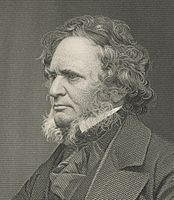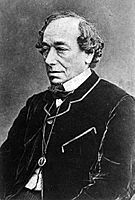Second Derby–Disraeli ministry facts for kids
Quick facts for kids Second Derby–Disraeli ministry |
|
|---|---|
| 1858–1859 | |
  |
|
| Date formed | 20 February 1858 |
| Date dissolved | 11 June 1859 |
| People and organisations | |
| Monarch | Victoria |
| Prime Minister | Lord Derby |
| Chancellor of the Exchequer | Benjamin Disraeli |
| Total no. of members | 78 appointments |
| Member party | Conservative Party |
| Status in legislature | Minority |
| Opposition party | Liberal Party |
| Opposition leaders |
|
| History | |
| Outgoing election | 1859 general election |
| Legislature term(s) | 17th UK Parliament |
| Predecessor | First Palmerston ministry |
| Successor | Second Palmerston ministry |
The government of the United Kingdom of Great Britain and Ireland between 1858 and 1859 was led by the Conservative Party. The main leader was Lord Derby, who was the Prime Minister and led the government in the House of Lords. Benjamin Disraeli was a very important figure in the government, leading it in the House of Commons and serving as Chancellor of the Exchequer.
Contents
History of the Derby Government
This government came into power after the previous leader, Lord Palmerston, lost support. Lord Derby then formed a new government. It was a minority government, which means his party did not have the most seats in Parliament. This made it harder for them to pass new laws.
One of the most important things this government did was to change how India was ruled. Before this, India was largely controlled by the British East India Company. The Derby government passed a law that brought India under the direct rule of the British Crown, meaning it was now governed directly by the Queen and the British Parliament. This was known as the establishment of Crown rule in India.
However, because it was a minority government, it struggled to stay in power. In June 1859, the government faced a vote of no confidence. This is when Parliament votes to show they no longer support the current government. Lord Derby's government lost this vote and had to step down. After this, Lord Palmerston returned to become Prime Minister again.
Key People in the Cabinet
A government's cabinet is a group of the most important ministers who help the Prime Minister make big decisions. Here are some of the key people in Lord Derby's cabinet:
Prime Minister and Chancellor
- The Earl of Derby was the Prime Minister and also the First Lord of the Treasury. He was in charge of the whole government.
- Benjamin Disraeli was the Chancellor of the Exchequer. This role is like the country's chief financial officer, in charge of money and taxes. He also led the government's work in the House of Commons.
Other Important Ministers
- The Lord Chelmsford was the Lord Chancellor. This is the head of the justice system and a senior member of the government.
- The Earl of Malmesbury was the Foreign Secretary. He was responsible for dealing with other countries.
- Spencer H. Walpole and later T.H.S. Sotheron Estcourt served as the Home Secretary. This person is in charge of law and order within the country.
- Lord Stanley was the Secretary of State for the Colonies and later the first Secretary of State for India. He oversaw Britain's colonies and, importantly, the new direct rule of India.
- General Jonathan Peel was the Secretary of State for War, responsible for the army.
- Sir John Pakington was the First Lord of the Admiralty, in charge of the navy.
These individuals worked together to run the country during Lord Derby's time as Prime Minister.

